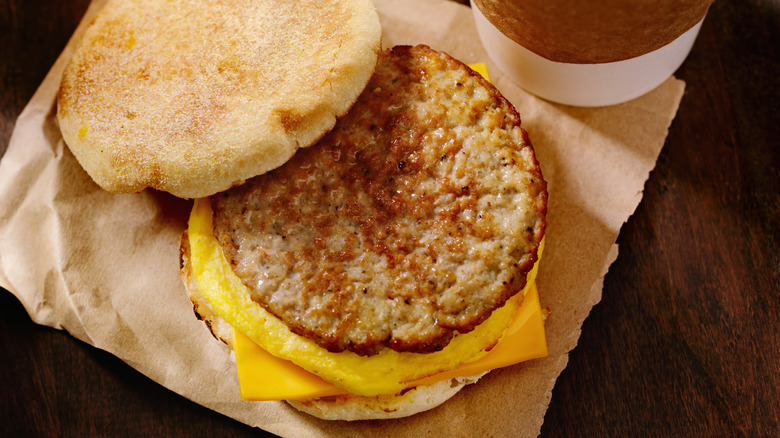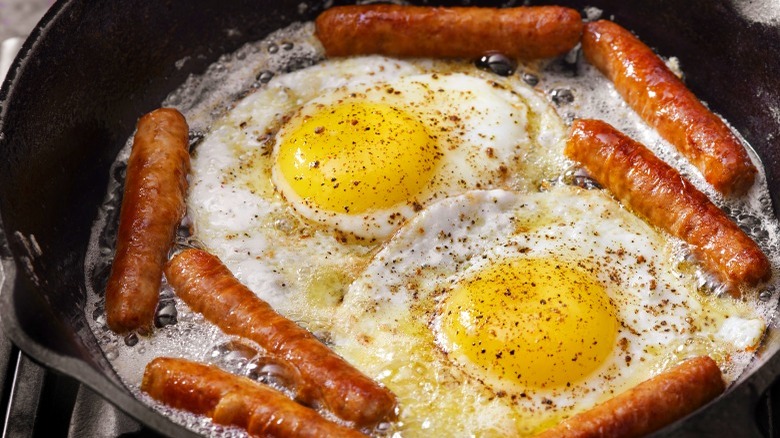What Makes Breakfast And Dinner Sausage Taste Different
When it's time for a fully-loaded breakfast or brunch, American breakfast sausage stars in recipes from breakfast burgers to delicious Scotch eggs. You'll find this comforting staple on any diner menu or bodega sandwich counter, too. But what exactly sets breakfast sausage aside from other varieties? There are about as many kinds of sausages as there are cuisines in the world, after all. As a very simple version, breakfast sausage is distinct thanks to a few key flavorings.
To start with, most breakfast sausages are made with a variety of specific herbs. The most important of these is sage. This addition gives breakfast sausage its woodsy, slightly peppery, herbal flavor, and it's found in most classic store-bought varieties at the supermarket. Other herbs can include thyme or rosemary, as well as spices like black pepper and cayenne. All of these options contribute to a flavor profile that is heavy on warm, woodsy flavors.
Maple syrup is often used as an ingredient, too. This amps up the salty-sweet notes in the meat, and it also ties the sausage's taste to other breakfast foods like bacon, pancakes, and French toast. If maple syrup isn't used, brown sugar or another sweetener is often added. That hint of maple sweetness definitely sets this sausage apart from more strictly savory "dinner" sausages.
The way breakfast sausage is made is also unique
A few other distinct traits define breakfast sausage as a unique product. While sausages can be made of virtually any protein, breakfast sausage is traditionally made with ground pork, though other meats like ground veal and turkey may be used in a recipe. It also has a looser structure than most "dinner" sausages. This is because the meat is not rested for as long after salting, giving the salt less time to dissolve the proteins and create a sausage with a tighter texture.
Most breakfast sausage is also less emulsified than other options. Emulsification refers to the process of grinding and mix the meat. The finer you grind and the heavier you mix, the more smooth your sausage will become — hot dogs are an example of a highly emulsified sausage. As with the salting process, breakfast sausage is commonly not mixed for as long, giving it a coarser texture.
Lastly, breakfast sausage is found in both links and case-less patties, while other styles might be defined by their shape. A bratwurst, for example, is always fit into a casing and formed into links. Breakfast sausage options can be found in thin discs, burger-shaped pucks, or traditional links. This is great news for home cooks, as it means you won't need to undergo the painstaking process of stuffing ground meat into a casing to make breakfast sausage.
Substituting breakfast sausage
Sometimes you're making a recipe that calls for breakfast sausage, but realize you don't have any. Does that sausage biscuit really require the breakfast version? If you're looking for an alternative, aim for something with a fairly mild flavor. Don't use something like Italian hot sausage, which is packed with bold seasonings like fennel and chili pepper. This will throw off the taste of the final dish. Cured, smoky spicy sausages like Spanish chorizo will also taste very different.
Your best bet might be to use a milder German sausage like a bratwurst. This will give you a warm flavor profile that isn't too far removed from American breakfast sausage. This isn't to say that more dinner-oriented sausages don't taste great in breakfast recipes, but if you're swapping them in, they will change the recipe quite a lot.
If you're looking for a plant-based alternative to breakfast sausage, you have plenty of options as well. To begin with, there are many brands of vegan breakfast sausage that can be found at your local supermarket or specialty store. You can also reach for umami-rich vegetables. A grilled or roasted portobello mushroom can make for a great meat substitute in a sausage, egg, and cheese sandwich. Try bringing in some classic flavorings of breakfast sausage too, like a drizzle of maple syrup or some sautéed sage, to double down on that breakfast taste.



